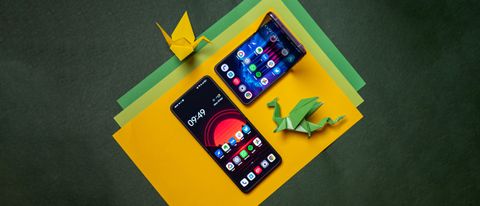Android Central Verdict
The Find N2 Flip outmatches the Galaxy Z Flip 4 in a lot of ways: it has a larger outer screen, bigger battery, faster charging, and the 50MP camera at the back takes better photos. The hinge is lighter and feels easier to use, and the crease is nearly invisible — you don't notice it at all in daily use. Yes, there are annoyances — there's no 4K at 60fps, and you miss out on wireless charging — but on the whole, the Find N2 Flip manages to deliver the features you actually need in a foldable, and it does so better than the Galaxy Z Flip 4.
Pros
- +
Gorgeous design with a smooth hinge
- +
Nearly invisible crease for the inner screen
- +
Large outer screen is great as a viewfinder
- +
Powerful hardware
- +
Outstanding battery life with fast 44W charging
- +
Four years of Android OS updates
Cons
- -
Outer screen is limited in its usability
- -
No 4K video at 60fps
- -
Wide-angle lens is strictly average, misses out on 4K video
- -
No IP rating
- -
No wireless charging
Why you can trust Android Central
While Samsung got all the early momentum in the foldable category, that's changing in 2023. Chinese brands are finally started to launch their products outside their home market, with the likes of the Honor Magic Vs showcasing a gorgeous design with a lightweight hinge and great cameras.
Another brand that's expanding its foldable push is OPPO. It showed off the second-gen Find N2 at the end of last year, and while that foldable is still limited to China, the company is now launching the Find N2 Flip in global markets, and that's a huge deal. What's particularly interesting about the Find N2 Flip is that it folds in half — just like the Galaxy Z Flip 4 — and you get a large 3.2-inch outer screen, giving it a distinct edge over Samsung's offering.
I used the Find N2 Flip for just under a month now, using it initially a secondary device and switching to it as my daily driver. While OPPO still has a few things to tweak on the software front, I'm not exaggerating when I say that the Find N2 Flip is my favorite flip phone.
OPPO Find N2 Flip: Availability
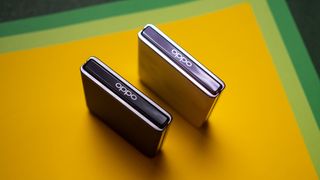
OPPO introduced the Find N2 Flip in China back in December 2022, and the foldable was unveiled for global markets at MWC. The phone is available in a single variant with 12GB of RAM and 256GB of storage, and it is now up for sale in the U.K. for £849 and in France for €1,099. You can pick up the foldable directly at OPPO's storefront, Amazon, or via local carriers.
The Find N2 Flip launched in India on March 13, and it is sold in an 8GB/256GB option.
OPPO Find N2 Flip: Design

The most striking design aspect of the Find N2 Flip is the outer screen, and it dominates attention when the foldable is closed. OPPO didn't stray too far from the design aesthetic of the fold-out Find N2, with the flip variant offering a similar look. The device looks effortlessly upmarket, and the best part about the design is that it folds fully flat with no visible gap between the screens.
That gives the Find N2 Flip an edge over the Galaxy Z Flip 4, which has a noticeable gap between the two halves of the screen thanks to the unique nature of Samsung's hinge. For its part, OPPO is using a version of the Flexion Hinge that it debuted on the Find N2, and it is brilliant. You get a smooth articulation with little resistance, and although it doesn't need as much force as the Galaxy Z Flip 4, it still manages to stay half-folded between 45 to 110 degrees, giving you the ability to shoot photos at interesting angles.
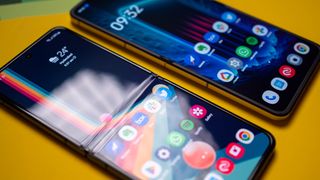
While that's good, what you'll appreciate more is the fact that the Find N2 Flip has the least visible crease of any of the foldables. OPPO did a magnificent job in this area, and while there's still a crease here, it isn't anywhere as pronounced in daily use as Samsung's foldable. You just don't notice the crease while scrolling or navigating the interface, and I think this particular trait goes a long way in making the foldable feel more like a traditional device.
As for the design itself, OPPO didn't veer too much off the beaten path, and the Find N2 Flip features two halves joined together by the hinge. The phone is sold in two color options — Astral Black and Moonlit Purple — and having used both, I'm partial to the Astral Black model. It has a silky pattern that's nearly identical to the OnePlus 11, and feels good in daily use. Although the purple version looks better, it has a glossy coat that isn't as exciting.

You'll find the OPPO branding across the hinge, and the manufacturer added a wave pattern along the length of the hinge to make it stand out a bit. The foldable has a similar design for the cameras at the back, with the sensors decked out in individual rings. The design adds to the industrial look of the phone, and doesn't make it look busy in the least.
The device is a smidgen taller than the Galaxy Z Flip 4, but it is still manageable when unfolded. But it's the added width that makes using the foldable a little easier; I found the Z Flip 4 to be a tad too narrow, and that isn't an issue here as the Find N2 Flip is 3.3mm wider. While it has a significantly larger battery, the foldable still comes in at a very decent 191g.
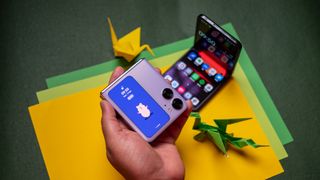
My biggest complaint with the Find N2 Flip has to do with the size of the outer screen. While I like the fact that it is the largest of any of the flip phones thus far, the fact that it extends almost to the entire length of the half meant my index finger inevitably rested on the screen when using the device unfolded, leading to a lot of smudges.
A close second is the authentication system. The Find N2 Flip has a fingerprint sensor that's baked into the power button on the side, and it works just as reliably as other modules of this nature — when the phone is unfolded. It is much more challenging when the phone is closed, and for the first two weeks I just could not get the device to unlock with my fingerprint when it was closed.
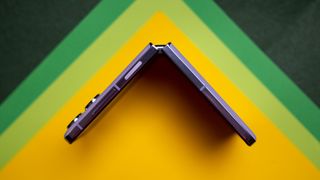
That's because the sensor is effectively upside down when the phone is folded. OPPO suggests setting up the fingerprint both ways — one with the inner screen facing you, and the other facing away — so that the module works the same when the device is closed and unfolded. Setting it up like this was a bit awkward, but it made unlocking the device much less of a hassle. Even so, I just switched to face unlock as it was much more straightforward.




The Find N2 Flip has the volume button above the power button, and you'll find the dual-SIM tray at the bottom next to the USB-C charging port. Like every foldable that isn't made by Samsung, the Find N2 Flip misses out on an IP rating, and while you'll find the usual rubber gaskets, you don't get any official guarantee around dust and water ingress.
Other that than omission, there isn't much missing here. OPPO is gunning for Samsung with the Find N2 Flip, and it has managed to deliver the goods — after using the device for nearly a month, I like the design and in-hand feel more than Samsung's foldable.
OPPO Find N2 Flip: Display
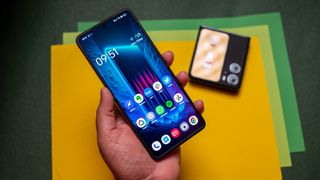
With a 3.26-inch AMOLED panel, the Find N2 Flip has the largest outer screen of any of the flip phones so far, and it makes a difference in daily use. The larger screen is great for viewing notifications, but the best use case is as a viewfinder for the camera, and it works very well in this setting.
The outer screen has a resolution of 720 x 382, and it goes up to 60Hz. The larger size gives the phone a big advantage over other devices in this category, but I can't help but feel that OPPO could have done more with the panel. As it stands, the usability of the outer screen is very limited; you have a few widgets for the camera, weather, recorder, and timer, and while you can view notifications, you'll need to unfold the phone and use the inner screen to undertake any actions.
It would have been much more useful to have a full-fledged second screen with actionable notifications and the ability to launch apps, that isn't available at the moment.
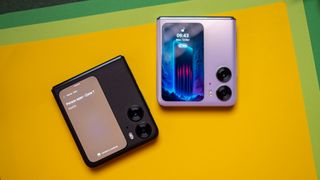
You do get the option of using canned responses for messages — you'll find a list of six responses as default, and you can add your own — but that's about it as far as actionable notifications go. What would absolutely make a difference is a utility like CoverScreen OS that unlocks the full capability of the screen, but that is limited to Samsung's foldables at the moment. Another annoyance is that you need to unlock the cover screen to pull up notifications or access the toggles, and it feels unnecessary.
Having said that, there is a decent amount of customizability here; you can use the always-on mode with the cover screen, and while all styles don't work — Insight doesn't show up on the outer screen — most standard styles can be used on the outside as well. But what I like best here is the ability to use an interactive pet on the cover screen.
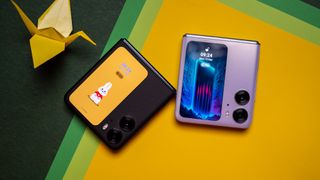
There are five animals to pick from — bird, hamster, rabbit, cat, and dog — and each animal has a unique set of animations that vary based on time of day. It is a fun element that makes the outer screen that much more engaging and playful. Finally, the outer screen has a layer of Gorilla Glass 5, and other than constant smudging, I didn't have any issues with the panel itself.
Coming to the inner screen, you get a 6.8-inch AMOLED panel with a resolution of 2520 x 1080, 120Hz refresh, and maximum brightness of up to 1200 nits. There are zero issues with the quality of the screen, and it delivers vibrant colors with excellent contrast levels. It is also noticeably brighter than Samsung's offering, and I didn't have any problems using the device under harsh sunlight. It features the usual plastic layer over the ultra-thin glass surface, and feels great in daily use.
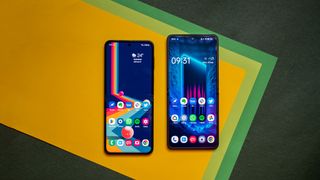
The added width means the Find N2 Flip feels like a regular phone, and while it is a little too tall for my liking, that's about the only quibble I have with the inner screen. There's stereo sound here, with the secondary speaker tucked into the grille above the screen. There's a vent for it up top, and you get good stereo separation while streaming videos and playing games.
It's clear that the large outer screen has a lot of potential, but that isn't being utilized at the moment. On the whole though, the Find N2 Flip has plenty to offer, and the inner screen is among the best you'll find on a foldable.
OPPO Find N2 Flip: Performance
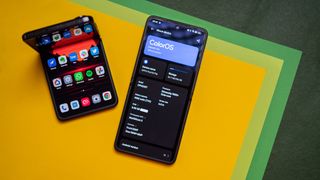
Qualcomm has dominated foldable market share, but with the Find N2 Flip, OPPO is using MediaTek's Dimensity 9000+ instead. The brand says the move was motived by a need to customize the chipset, and that going with MediaTek allowed OPPO to tweak the platform to eke out better battery life.
| Category | OPPO Find N2 Flip |
|---|---|
| OS | ColorOS 13 based on Android 13 |
| Outer Display | 3.26-inch 60Hz AMOLED, 720 x 382, 800 nits, Gorilla Glass 5 |
| Inner Display | 6.8-inch 120Hz AMOLED, 2520 x 1080, 1200 nits, HDR10+ |
| Chipset | MediaTek Dimensity 9000+, 1 x 3.2GHz Cortex X2, 3 x 2.85GHz Cortex A710, 4 x 1.8GHz Cortex A510, Mali-G710, 4nm |
| RAM | 12GB LPDDR5X |
| Storage | 256GB UFS 3.1 |
| Rear camera 1 | 50MP f/1.8 Sony IMX 890, 1.0um pixels, PDAF, 4K at 30fps |
| Rear camera 2 | 8MP f/2.2 wide-angle, 112-degree FoV |
| Front camera | 32MP f/2.4, autofocus |
| Ingress protection | None |
| Connectivity | Wi-Fi 6, Bluetooth 5.3, NFC, Sub-6 5G |
| Security | Side-mounted fingerprint sensor |
| Audio | Stereo sound, USB-C, AptX HD codec |
| Battery | 4300mAh, 44W fast charging |
| Dimensions (unfolded) | 166.2 x 75.2 x 7.5mm |
| Dimensions (folded) | 85.5 x 75.2 x 16mm |
| Weight | 191g |
| Colors | Astral Black, Moonlit Purple |
While the Dimensity 9000+ is powerful in its own right, it doesn't quite manage to hold its own against the Snapdragon 8 Gen 2. That said, the phone feels fluid in daily use, and I didn't see any lag or slowdowns.
Like all foldables, the Find N2 Flip is thermally constrained and doesn't deliver the same level of sustained performance as regular phones, so you'll notice some throttling during extended gaming sessions. Outside of that, it is just as stable as other Dimensity 9000+-powered phones I used in the last six months.
| Category | Galaxy Z Flip 4 | Find N2 Flip | Galaxy S23 Ultra |
|---|---|---|---|
| CrossMark (Overall) | 820 | 939 | 1295 |
| Productivity | 738 | 839 | 1185 |
| Creativity | 905 | 1036 | 1411 |
| Responsiveness | 833 | 988 | 1310 |
| Geekbench 6 (single-core) | 1524 | 1216 | 1931 |
| Geekbench 6 (multi-core) | 3031 | 3361 | 4971 |
| 3DMark Wild Life Extreme (score) | 2528 | 2432 | 3488 |
| 3DMark Wild Life Extreme (FPS) | 15.1 | 14.5 | 20.9 |
The Find N2 Flip is largely in line with the Galaxy Z Flip 4 in most synthetic workloads, and that holds up in real-world usage as well. It is among the best foldables at the moment, and while the Dimensity 9000+ is found lacking against the likes of the Galaxy S23 Ultra, it holds up just fine in daily use.
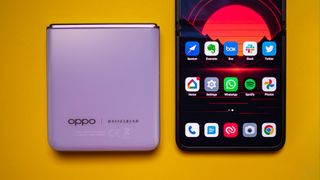
Globally, the Find N2 Flip is offered in a single option with 12GB of LPDDR5X RAM and 256GB of storage, and as a consequence of the device launching officially at the end of last year, it features UFS 3.1 memory and misses out on the latest UFS 4.0 storage module. That said, there are no issues on the hardware front, and UFS 3.1 still has a lot to offer in 2023.
Elsewhere, you get Wi-Fi 6, Bluetooth 5.3, NFC, AptX HD audio codec, dual-band GPS, and global Sub-6 5G bands. There's a good vibration motor here, and while it doesn't offer the same level of feedback as the likes of the OnePlus 11, it has a lot going for it.
Even though you don't get Qualcomm hardware here, the Find N2 Flip delivers stellar performance in daily use, and that will be the case for several years to come.
OPPO Find N2 Flip: Battery life
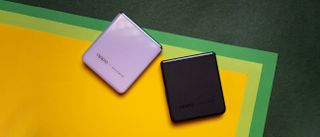
The Find N2 Flip features a 4300mAh battery, and while that may not seem particularly impressive considering most flagships now offer a 5000mAh battery, it is the largest we've seen yet on a flip phone. It's significantly larger than what you get on the Z Flip 4, and the difference is immediately noticeable — there's no reason for any battery anxiety here, and that feels great.
Even with heavy use and always-on mode enabled, the Find N2 Flip managed to last an entire day with ease. The battery longevity isn't quite on par with the best Android phones featuring Qualcomm's latest silicon, but that isn't the yardstick for the Find N2 Flip. It is instead aiming to deliver better figures than the Z Flip 4 and other flip phones, and it manages to do just that.

The phone also charges faster than its rivals. It offers 44W wired charging, with a 67W charger bundled in the package. The battery takes just over an hour to fully charge, and you'll get to the halfway point in 20 minutes. Not stellar figures, but again, better than other foldables. There isn't wireless charging here, with the brand leaving out the feature to create a thinner device.
OPPO Find N2 Flip: Cameras

Space is at a significant premium on a foldable — more so than a regular phone — so brands have traditionally offered two cameras at the back. That's true here as well: you get a 50MP Sony IMX890 main camera with f/1.8 lens and OIS, and it's joined by an 8MP f/2.2 Sony IMX355 wide-angle lens with a 112-degree field of view. Up front, you'll find a 32MP f/2.4Sony IMX709 with autofocus.
The camera interface itself is identical to other phones running ColorOS 13, with all the shooting modes laid out at the bottom and toggles readily accessible. While there's no zoom lens, you get 2x digital zoom, and the images are strictly average.

One of the best use cases for the large cover screen is as a viewfinder, and it works really well. The camera widget has three modes — photo, portrait, and video — and while you miss out on granular controls, it offers an easy way to shoot selfies via the rear camera should you need to do so.
Dual Screen Preview is a fun feature that lets you preview the viewfinder on the cover screen when you're using the inner screen, and like Samsung's foldables, you get FlexForm mode here. It unlocks a whole new set of use cases and lets you shoot at interesting angles.






As you'd imagine, the main camera does an incredible job in all scenarios, and the Hasselblad integration means you get various filters and styles to play with. The resultant shots have plenty of detail, great dynamic range, and good color balance that's saturated without going overboard on the contrast levels. The phone does a better job than the Z Flip 4 in low-light situations, delivering photos with vibrant colors, minimal noise levels, and good overall detail.
My main issue with the cameras is around the wide-angle lens. The 8MP module just doesn't belong on a premium phone, and while it is decent enough, it doesn't produce shots of the same caliber as the main lens.
Clearly, the focus with the phone is around photos, and although the device gets OPPO's custom 6nm MariSilicon X chipset, it isn't being fully utilized. The MariSilicon X is designed to turbocharge 4K ultra night video, but the Find N2 Flip only shoots 4K video at 30fps, with no ability to shoot at 60fps. This is a bizarre limitation as the Dimensity 9000+ and the IMX890 can both shoot 4K at 60fps, so I don't understand why the device doesn't allow the same.
In a similar vein, there's no 4K video at all for the wide-angle lens, and you're limited to 1080p. The full-fledged Find N2 has the 48MP Sony IMX581 as the wide-angle lens, so I'm not sure why that same module wasn't used here.
So while there is a lot of potential for the main 50MP camera, the wide-angle lens is nowhere as good, and the foldable doesn't quite pass muster when it comes to shooting videos.
OPPO Find N2 Flip: Software
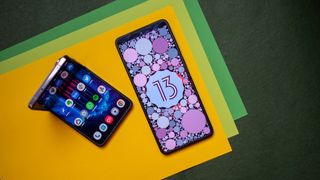
The Find N2 Flip runs ColorOS 13 based on Android 13 out of the box. For the most part, the software is clean, refined, and fluid, and you get a ton of customizability. One of the key additions in ColorOS 13 is the inclusion of always-on styles that have been limited to OxygenOS in the past, so you get the likes of Insight and Bitmoji.
Another interesting addition is a contextual mode that pulls in data from food delivery services and surfaces that directly on the always-on screen, making it easy to see how the status of your food delivery. There's also Spotify integration, so you can pause or play music and switch tracks without ever having to unlock the screen.
ColorOS 13 has its own version of the Material You dynamic color picker, with the interface letting you choose accent colors based on the phone background. While you get only one color palette this way — Google lets you pick from 16 variations — you have the ability to tweak individual colors or create your own. The basics are sorted out as well: you get Gboard out of the box, and transferring data from my old phone was just as straightforward as other devices I've used this year.

Elsewhere, the notification shade has two large tiles for Wi-Fi and Bluetooth, and while future versions of ColorOS will have a split notification pane — similar to iOS and MIUI — that thankfully isn't the case for now. The interface as a whole feels polished, and there isn't much in the way of bloatware. You get a decent mix of features here, and the optimized UI makes using the Find N2 Flip enjoyable.
That said, the phone isn't without weird glitches. I use Box to store documents, and the app wouldn't load on the device, instead switching to a web view. I couldn't get the Device controls tile to work with Home or Home Assistant, and it wouldn't surface the smart lighting and other products located within each service.
Outside of those minor annoyances, using ColorOS 13 has been great so far. There's good news on the software update front too, with the phone guaranteed to pick up four Android OS updates and five years of security patches — identical to Samsung. OPPO is doing a good job with timely updates, so there shouldn't be any issues with long-term usage.
OPPO Find N2 Flip: The competition

Samsung is the brand to beat when it comes to foldables, with the Galaxy Z Flip 4 throwing down the gauntlet for other devices. The phone has a wedge-style hinge and doesn't close fully flat, and the screen isn't as good to use — the crease is clearly visible, and the plastic layer isn't as thin as the Find N2 Flip.
The inner screen of the Z Flip 4 is a bit too narrow for my liking, the outer screen is too small to be of any use other than a viewfinder, and the battery doesn't last long. Now, the Z Flip 4 has more powerful hardware, and you get better software features. Overall though, the Find N2 Flip feels better to hold and use than the Z Flip 4, and while it misses out on an IP rating and wireless charging, it gets a lot right elsewhere.
Samsung made a lot of ground thanks to its early-mover advantage, but with the Chinese contingent now offering their alternatives, it needs to do something different to stand out in 2023.
OPPO Find N2 Flip: Should you buy it?
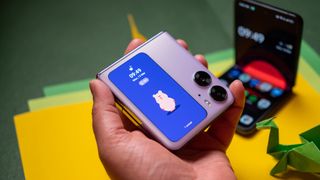
You should buy this if:
- You want a flip-style foldable with a large outer screen
- You need powerful hardware and a battery that lasts all day
- You want a foldable with an invisible crease
- You need a good camera
- You want long-term software updates
You shouldn't buy this if:
- You need a foldable for taking videos
- You absolutely need wireless charging
- You want IP68 dust and water resistance
- You need a good wide-angle lens
I was excited when OPPO initially announced that it would launch the Find N2 Flip in global markets, and after using it for just under a month, I like it more than the Galaxy Z Flip 4. It just feels better to hold and use, and the hinge is a lot smoother and requires less effort to unfold. I also like the large outer screen and the customizability, but OPPO definitely needs to do more to unlock its full potential.
I like the added width of the inner screen — this continues to be an issue on the Z Flip 4 — and the panel itself is among the best on a foldable. The best part is that the crease is barely invisible in daily use, and this more than anything else gives the Find N2 Flip a huge edge over other flip phones. It also lasts longer than its rivals, and charges faster.
The camera takes great photos as well, but the wide-angle lens is an afterthought; it doesn't belong on a high-end phone. There's a lot to like with the software, and the fact that the phone gets four Android OS updates is a huge deal. Overall, OPPO did a magnificent job with the Find N2 Flip, and the phone is not just a real contender to the Galaxy Z Flip 4, but it manages to come out ahead in a lot of key areas.

Harish Jonnalagadda is a Senior Editor overseeing Asia at Android Central. He leads the site's coverage of Chinese phone brands, contributing to reviews, features, and buying guides. He also writes about storage servers, audio products, and the semiconductor industry. Contact him on Twitter at @chunkynerd.
